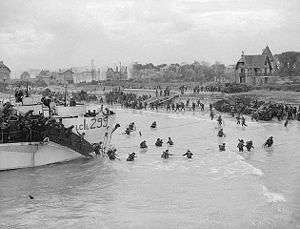Small Box Girder

The Small Box Girder bridge (SBG) was a small assault bridge that could be used to span gaps of up to 30 feet.[1] It was typically carried on a tank, such as the Churchill Armoured Vehicle Royal Engineers (AVRE) or something similar, and could be deployed without engineers having to expose themselves to enemy fire. The design had been formally adopted by the British Army in 1932. Pre-war the SBG had (more often than not without permission) quickly been copied by many countries around the world, including ironically Germany. The German Army called their version of the SBG the Kastenrager-Great (K-Gerat for short).[2] The United States was another country whose army created their own copy, designating it the H-20.
The SBG was used during the Normandy invasion of World War II (1944–5).[3]
See also
References
- ↑ "Time Money and Blood". The Canadian soldier in the 20th century. Retrieved 26 October 2012. External link in
|work=(help) - ↑ Think Defence (30 December 2011). "UK Military Bridging – Equipment (Pre WWII Equipment Bridging)". www.thinkdefence.co.uk. Retrieved 8 May 2017.
The Small Box Girder bridge was copied and used by many other nations including Germany (where it was called the Kastenrager-Gerät or K-Gerät) and the United States where it was called the H-20.
- ↑ "Special purpose bridging — SBG & ARC". Time Money and Blood. Retrieved 26 October 2012. External link in
|work=(help)